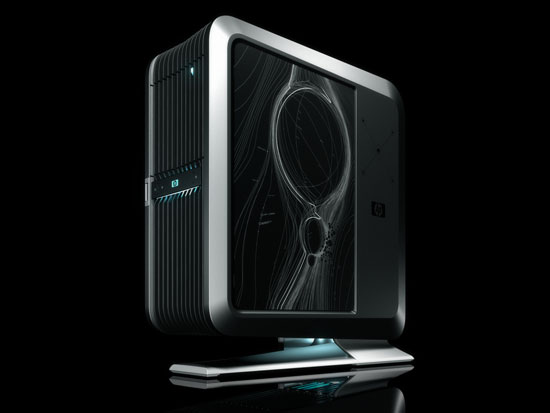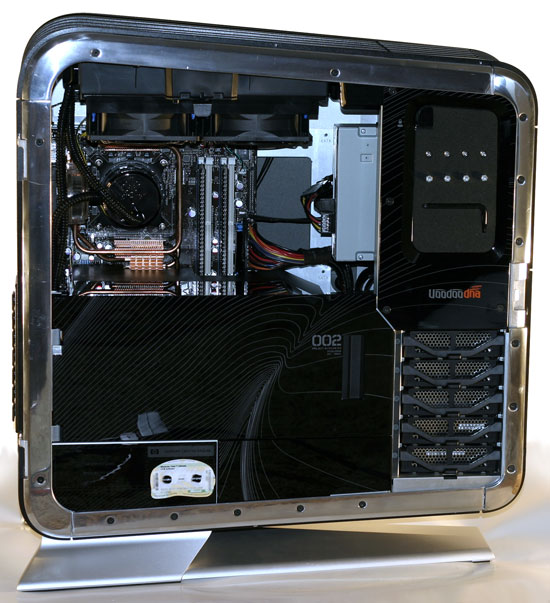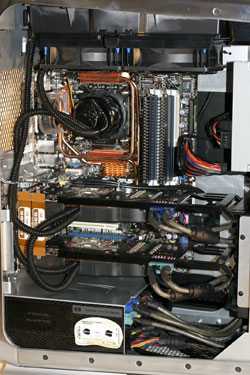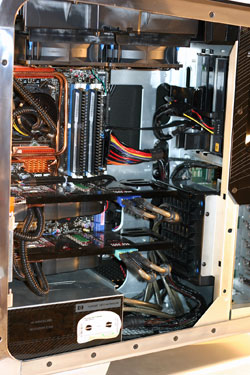Blackbird 002, Take Two
One of the most impressive aspects about the Blackbird is undoubtedly the case design. This isn't just your typical rectangular computer case with a window, some lights, a design cut into the metal, and a fancy paint job. As we mentioned in the previous article, the fully assembled case is quite heavy, but it's also extremely sturdy. The case is made from cast aluminum, and the main structure is extremely thick aluminum. The system we were shipped weighs about 70 pounds, and while the liquid cooling certainly accounts for some of the weight, the thick shell is the primary contributor.
One of the aspects of the case that we didn't mention previously (in part because we weren't aware of this fact at the time) is that the case door can actually be easily removed. Swing the door open and lift up on it and you can pull it off the pins and set it aside while you access the internals. Because of the heavy-duty design, this can all be accomplished without compromising structural integrity.
Other than looking cool and weighing a lot, the design of the case does serve other purposes. First, the raised chassis opens up a sixth side of cooling: air can now come in the bottom of the case. This may not be strictly necessary, but with the compartmental design that HP has created the bottom intake provides fresh air to the power supply.
The purpose of the compartmentalized design is to provide optimal cooling to all of the major components without creating a bunch of turbulence, so the internals are broken up into three main sections: at the bottom is the power supply, in the middle are the expansion cards, and at the top we find the CPU and water cooling system. The hard drives are located towards the front of the chassis and cooled by an internal 120mm fan that also provides airflow to the expansion cards. Having this fan located several inches inside the chassis allows it to provide airflow without generating much in the way of audible noise.
The panel that holds the expansion cards in place swings open with a quick release of the latch, and like the main door this can also be removed. Other plastic panels that help divide the interior into compartments can also be removed, and with all of these out of the way users get quick and easy access to the internals.
Upgrading expansion cards - outside of dealing with the water cooling on the GPU(s) if you get the LCi version - adding or removing hard drives, or swapping out the secondary optical drive can all be done in a matter of minutes without ever needing to touch a tool. We've seen plenty of tool-less case designs over the years, but without a doubt this is one of the slickest approaches that we've ever had the pleasure of using. It's also important to remember that even with the unique case construction, all the components contained within the Blackbird are all standard ATX offerings.
All of this raises some interesting points of discussion in regards to the case. Assuming that the cumbersome weight isn't a problem - it will be for some people but not for others - how much are we actually talking about spending on just the case? A lot of people are perfectly happy with the typical Antec and Cooler Master budget cases, but some people want a truly high-quality case like a Lian Li and they're willing to spend several hundred dollars if necessary. Will it be possible for users to simply bypass HP and purchase the case separately? (For now, the answer is no, but if enough people are interested HP might have a change of heart.) If you're looking at building a completely new high-end computer anyway, however, that might not even be necessary provided that HP's prices are reasonable. So how does HP's pricing of the Blackbird compare with a DIY build?
One of the most impressive aspects about the Blackbird is undoubtedly the case design. This isn't just your typical rectangular computer case with a window, some lights, a design cut into the metal, and a fancy paint job. As we mentioned in the previous article, the fully assembled case is quite heavy, but it's also extremely sturdy. The case is made from cast aluminum, and the main structure is extremely thick aluminum. The system we were shipped weighs about 70 pounds, and while the liquid cooling certainly accounts for some of the weight, the thick shell is the primary contributor.
 |
One of the aspects of the case that we didn't mention previously (in part because we weren't aware of this fact at the time) is that the case door can actually be easily removed. Swing the door open and lift up on it and you can pull it off the pins and set it aside while you access the internals. Because of the heavy-duty design, this can all be accomplished without compromising structural integrity.
Other than looking cool and weighing a lot, the design of the case does serve other purposes. First, the raised chassis opens up a sixth side of cooling: air can now come in the bottom of the case. This may not be strictly necessary, but with the compartmental design that HP has created the bottom intake provides fresh air to the power supply.
 |
The purpose of the compartmentalized design is to provide optimal cooling to all of the major components without creating a bunch of turbulence, so the internals are broken up into three main sections: at the bottom is the power supply, in the middle are the expansion cards, and at the top we find the CPU and water cooling system. The hard drives are located towards the front of the chassis and cooled by an internal 120mm fan that also provides airflow to the expansion cards. Having this fan located several inches inside the chassis allows it to provide airflow without generating much in the way of audible noise.
 |
 |
The panel that holds the expansion cards in place swings open with a quick release of the latch, and like the main door this can also be removed. Other plastic panels that help divide the interior into compartments can also be removed, and with all of these out of the way users get quick and easy access to the internals.
Upgrading expansion cards - outside of dealing with the water cooling on the GPU(s) if you get the LCi version - adding or removing hard drives, or swapping out the secondary optical drive can all be done in a matter of minutes without ever needing to touch a tool. We've seen plenty of tool-less case designs over the years, but without a doubt this is one of the slickest approaches that we've ever had the pleasure of using. It's also important to remember that even with the unique case construction, all the components contained within the Blackbird are all standard ATX offerings.
All of this raises some interesting points of discussion in regards to the case. Assuming that the cumbersome weight isn't a problem - it will be for some people but not for others - how much are we actually talking about spending on just the case? A lot of people are perfectly happy with the typical Antec and Cooler Master budget cases, but some people want a truly high-quality case like a Lian Li and they're willing to spend several hundred dollars if necessary. Will it be possible for users to simply bypass HP and purchase the case separately? (For now, the answer is no, but if enough people are interested HP might have a change of heart.) If you're looking at building a completely new high-end computer anyway, however, that might not even be necessary provided that HP's prices are reasonable. So how does HP's pricing of the Blackbird compare with a DIY build?










33 Comments
View All Comments
JarredWalton - Thursday, October 4, 2007 - link
I don't mean Blackbird for $1500 - I just mean I want to see more interesting PC offerings in the $1500 and under range. Blackbird starts at $2500 which is pretty high-end. Now let's see some true midrange (and maybe even entry-level) stuff from HP Gaming.nets - Thursday, October 4, 2007 - link
But once again if the PARTS cost more than $1,500 how can the full PC cost less?strikeback03 - Thursday, October 4, 2007 - link
why would the parts have to cost more than $1500? I'm guessing he is referring to something more along the lines of an overclocked E6xxx or E4xxx, an 8800GTS 320, etc. Say $900-1100 worth of parts plus assembly/tuning/warranty, etc.nets - Thursday, October 4, 2007 - link
True, but in the article his DIY machine was $3,100. If I'm going to game on a PC I want at least a 24" monitor with max settings on games and 60 fps.What is the minimum price for parts that I can play COH or Crysis on and get that?
JarredWalton - Thursday, October 4, 2007 - link
We don't know on Crysis yet, but Company of Heroes is more dependent on the GPU, and even an 8800 GTS runs it very well (provided you don't try the crazy-slow DX10 effects). So, just as an example:E6550 = $180
2GB RAM = $125
P35 board = $115
8800 GTS 640 = $350
500GB HDD = $100
DVDR = $40
Case = ??? (something custom would be nice if possible, or else just a decent $50 for DIY)
620W Corsair PSU = $120
Keyboard and Mouse = $50 (decent quality options)
24" LCD = $400~$700 depending on brand
Vista = $130
Rough Total = $1530 (plus shipping and tax) *with* a 24" LCD.
That's just a quick estimate, and actual prices might be off $10-$20 on some components. Still, since the Blackbird price didn't include a display, you can pretty much get a great gaming PC for $1100. $1200 will get you Q6600 quad-core as well (which of course does *nothing* for any current game I'm aware of).
nets - Thursday, October 4, 2007 - link
Not bad. I guess I got so caught up in 'super machines' I forgot what other options there are. But man, that is kinda low end. Gotta have an overclocked 8800 GTX and I'd want an extra 10,000 rpm HD, wireless keyboard and mouse, plus you need an OSJarredWalton - Thursday, October 4, 2007 - link
10k RPM is 90% hype. Oh, they're faster, but it's not a night and day thing for most people. I'm still using 7200RPM drives and am quite happy. More RAM helps, particularly with Vista. Anyway, the above *does* include an (OEM) version of Vista, so basically $1530 gets you a complete upper-midrange gaming system.nets - Thursday, October 4, 2007 - link
Oh yes, I see Vista on there now - missed it the first time.I'd say "upper-midrange" for that system sounds right
JarredWalton - Tuesday, October 2, 2007 - link
Isn't that exactly what I did on page 3? Those parts and prices are what I found on the open market, and other than the case (which can't be purchased), you can get the total price. You're paying $1400 for the case and assembly (and support I suppose). That $4100 without case holds for the same parts from Alienware, Dell, VoodooPC, Gateway, etc. So, throw in a nice case like I did on page 4 and you can get the same setup as the Blackbird 002 for around $4400 (plus shipping and tax, as appropriate). Or you can go the overclocking route as I did at the bottom of page 4 and get the same thing for $3100.EateryOfPiza - Tuesday, October 2, 2007 - link
I was thinking of actual benchmark numbers from the DIY vs the VoodooPC solution.